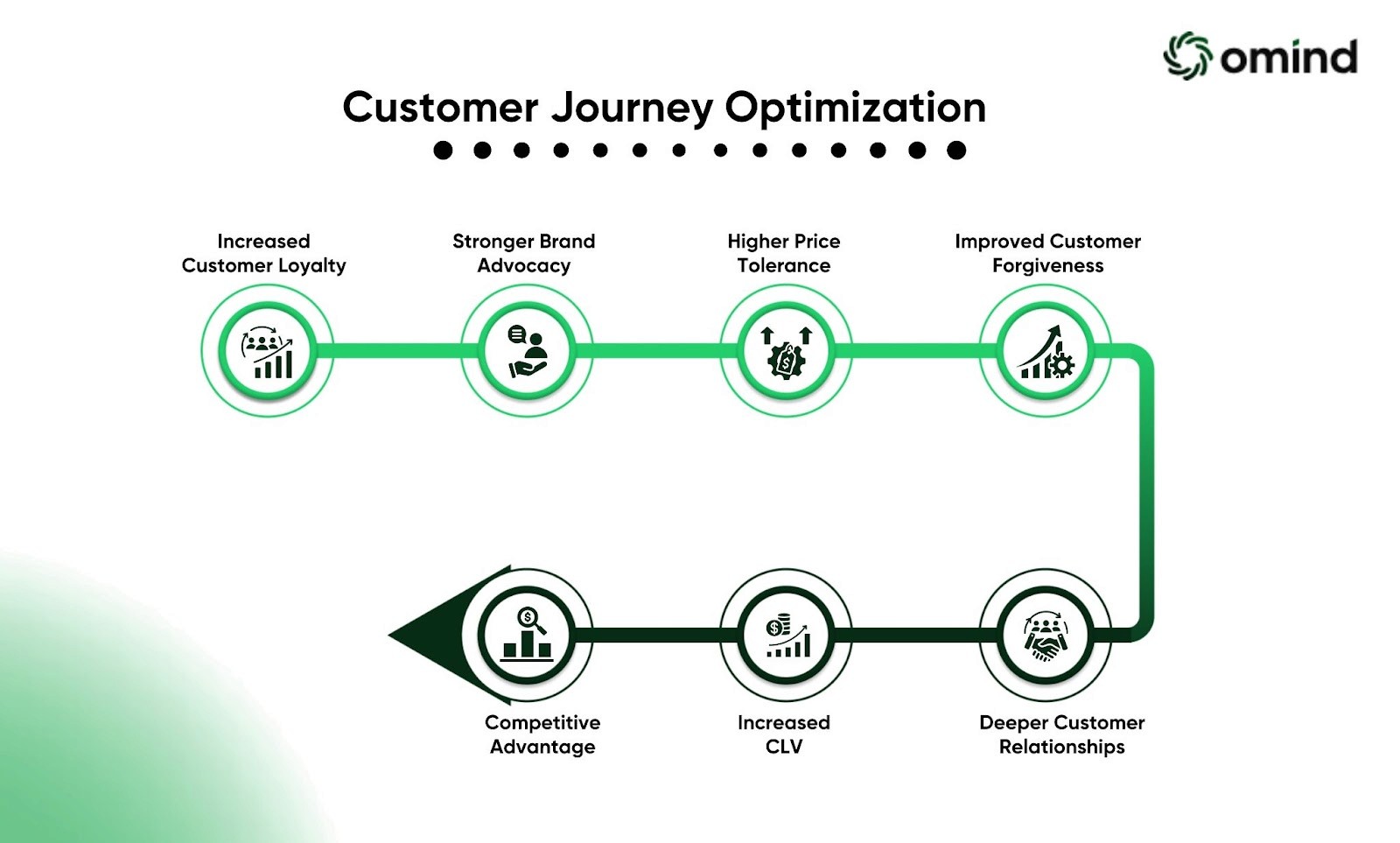We have spoken about customer journeys and the importance of understanding every step of the customer journey in the past. We’ve also spoken about how you can use customer journey mapping to better understand the interactions your customers have with your business. As a business, it’s important to be shaping every interaction a customer has with your business to create a positive outcome for the both of you. 52% of businesses now adapt their marketing strategies based on what the customer’s interactions with them have been so far.
A well-planned journey directly impacts business success, driving increased loyalty, higher revenue, and stronger brand reputation. Today's customers engage across multiple channels and touchpoints, demanding a dynamic and tailored experience.
Let’s therefore see how we can optimize this customer journey so that you and your customers can benefit from all the stages.
Strategies for Effective Customer Journey Mapping
To create a comprehensive understanding of how customers interact with your brand, start by segmenting your customer base. Divide customers into groups based on shared characteristics such as demographics, behaviors, or purchase history. This segmentation allows you to tailor your efforts and messaging to specific customer groups.
Next, develop detailed profiles of your ideal customers, known as archetypes. These fictional representations should encapsulate the goals, challenges, and preferences of different customer segments. By humanizing your target audience, you can better empathize with their needs and craft experiences that resonate. Then, you can use data to gain insights into customer behavior. Analyze website traffic patterns, purchase history, and social media engagement to identify trends and preferences. This data can help pinpoint opportunities to improve the customer experience.
To visualize the customer journey, create a map that outlines the steps customers take from initial awareness to post-purchase interactions. Identify all touchpoints where customers interact with your brand, both online and offline. Analyze each touchpoint to identify areas of friction that may hinder the customer experience.
Personalization In Customer Journey Optimization

Personalization is the art of tailoring customer interactions to individual preferences and behaviors. Personalization is what sets apart a generic marketing message, and experiences that feel uniquely crafted for each customer. Over 69% of people felt comfortable with personalization when it was based on data that they had shared with the business. By using data on customer preferences, purchase history, browsing behavior, and demographics, businesses can create highly personalized marketing campaigns, product recommendations, and offers.
There are several benefits to adapting a customer journey for personalization:
Increased customer loyalty: Customers who feel understood and valued are more likely to become repeat customers.
Stronger brand advocacy: Satisfied customers are more likely to recommend the brand to friends and family.
Higher price tolerance: Personalized experiences can justify premium pricing. After all, it does cost extra to have something tailor-made.
Improved customer forgiveness: Customers are more likely to overlook minor service issues.
Deeper customer relationships: Personalization fosters a sense of connection and trust.
Increased customer lifetime value: Loyal customers tend to spend more over time.
Competitive advantage: Offering personalized experiences sets businesses apart from competitors.
Embracing an Omnichannel Approach
Consistency is paramount in today’s multi-channel marketplace. To deliver exceptional customer experiences, businesses must ensure a seamless journey across all touchpoints, whether it's a website, mobile app, social media platform, or physical store. An omnichannel strategy consists of creating a unified and cohesive experience that caters to the customer's preferences and behaviors.
By adopting an omnichannel approach, businesses can gain a comprehensive view of their customers. Google reports that omnichannel strategies can drive store visits up by 80%. By integrating data from various channels, companies can create detailed customer profiles, enabling them to deliver highly personalized experiences.
Ultimately, an omnichannel strategy lets businesses meet customers where they are, providing relevant and timely interactions. By offering consistent messaging, pricing, and promotions across all channels, businesses can build trust and loyalty, increasing the likelihood of repeat purchases and customer advocacy.
Harnessing Technology to Enhance the Customer Experience

Technology has become an indispensable tool for businesses looking to elevate customer experiences. McKinsey suggests that the internet will eventually be responsible for 50% of the world’s entire retail business transactions.
AI-powered chatbots offer instant support, answering customer queries and resolving issues efficiently. These virtual assistants can handle routine inquiries, freeing up human agents to focus on more complex problems. Chatbots can also be programmed to learn from customer interactions, improving their responses over time.
Personalization engines, fueled by AI and ML, analyze customer data to deliver tailored recommendations and offers. By understanding individual preferences and behaviors, businesses can create highly relevant experiences that resonate with customers.
Marketing automation platforms like Omind help centralize customer data, enabling businesses to orchestrate personalized campaigns across multiple channels. These platforms automate repetitive tasks, allowing marketers to focus on strategy and creativity. By adapting to automation, businesses can deliver timely and relevant messages that nurture customer relationships and drive conversions.
Customer Support And Feedback Is Crucial
Exceptional customer service is the bedrock of a strong customer relationship. By training staff to be knowledgeable, responsive, and empathetic, along with offering multiple support channels such as phone, email, live chat, and social media, customers can access assistance when and how they prefer.
Customer support is important, but customer feedback is an equally invaluable resource for identifying areas of strength and weakness. By implementing surveys and feedback forms, businesses can gather insights into customer experiences. Incorporating open-ended questions allows for the collection of rich, qualitative data that reveals deeper customer sentiments. Analyzing this feedback helps identify trends and patterns, enabling companies to make data-driven improvements.
Demonstrating a commitment to acting on customer feedback is crucial. By implementing changes based on customer input, businesses show that they value their customers' opinions and are dedicated to enhancing the customer experience. This approach not only boosts customer satisfaction but also strengthens brand reputation.
Analytics and Continuous Improvement

To truly optimize the customer journey, businesses must embrace an analytical approach. Tracking KPIs such as customer satisfaction scores, net promoter scores, and customer lifetime value provides valuable insights into customer sentiment and loyalty. By analyzing these metrics, businesses can identify areas where the customer experience falls short and prioritize improvement initiatives.
Data-driven decision-making is essential for refining the customer journey. By leveraging analytics to uncover patterns and trends in customer behavior, businesses can make informed decisions about product offerings, marketing strategies, and service enhancements. Such a process of data analysis and optimization ensures that the customer journey evolves in tandem with changing customer needs and preferences.
Specific analytics tools like customer segmentation and A/B testing can provide deeper insights. Customer segmentation helps identify distinct customer groups with similar characteristics, allowing for tailored experiences. A/B testing enables businesses to compare different versions of web pages, email campaigns, or product offerings to determine which performs best.
Optimize For Better Retention
A culture of continuous improvement is vital for long-term success. By regularly reviewing and refining the customer journey based on data insights and customer feedback, businesses can create a competitive advantage. This commitment to excellence fosters customer loyalty, drives business growth, and positions the company as a leader in its industry.
To get started with your customer journey optimization, consider a solution like Omind, that uses AI to bring to you a conversational platform that helps visitors engage with your business. To see how our platform works, schedule a demo today.
AUTHOR
Team Omind
Empowering Businesses with Unified Customer Experience Platform, Leveraging Advanced AI and Intelligent Automation
PRODUCT
Unified CXM
Share LINK
Related Blogs




